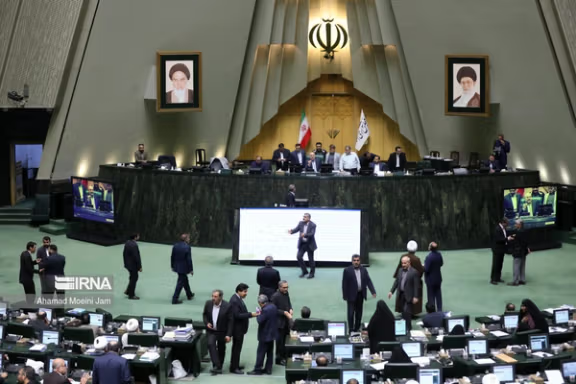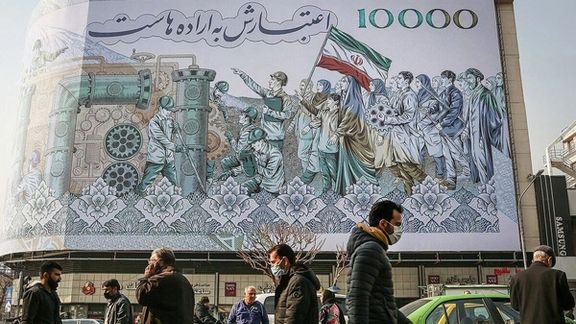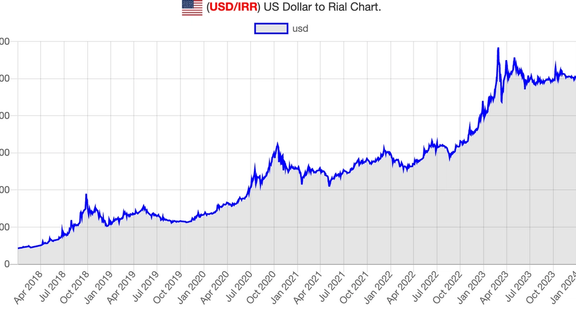Workers Protests Continues In Iran Amid Economic Strain

The Iranian National Steel Industrial Group in Ahvaz witnessed its sixth consecutive day of protest on Sunday, as workers gathered to voice their grievances.

The Iranian National Steel Industrial Group in Ahvaz witnessed its sixth consecutive day of protest on Sunday, as workers gathered to voice their grievances.
The demonstrators, who abstained from work, demanded the implementation of job classifications and better working conditions.
Marching through the streets, the striking workers rallied in front of the Ahvaz Governorate and the central building of the Khuzestan National Bank, chanting slogans such as "We haven't seen justice; we won't vote anymore." Ahvaz is the capital of Iran's oil-rich Khuzestan province.
The Iranian National Steel Industrial Group, previously under the control of the Amir Mansour Aria Investment Company, underwent a change in ownership following legal proceedings and the execution of the founder for embezzlement.
In a parallel display of dissent, employees of the Gachsaran Oil and Gas Exploitation Company gathered for a protest within the company's premises, demanding solutions to livelihood problems and an increase in wages, salaries, and benefits.
Meanwhile, workers of the Makran Desalination Project staged a strike on Sunday over the non-payment of overdue wages and salaries by the employer, adding to the chorus of discontent across various sectors.
The protests reflect a broader trend of dissatisfaction with fast rising inflation that significantly outpaces wages, as workers, guild members, and retirees voice their concerns. However, such demonstrations have often been met with security force crackdowns.

In a recent parliamentary session, lawmakers in Iran reportedly set the pay scale for government employees and retirees for the new financial year starting March 21.
The base salary for government workers was fixed at 100 million rials, while a minimum pension of 90 million rials was endorsed for retirees. The bill, presented during Saturday's session, garnered approval with 123 votes in favor, 53 against, and 11 abstentions out of 193 lawmakers out of 290 present.
The decision arrives as Iranian workers are about to receive a government-approved average minimum wage increase of 20 percent, scheduled to come into effect in March. The development unfolds against the backdrop of an alarming annual inflation rate nearing 50 percent. The timing underscores the delicate balance between consumers' purchasing power and the rising US dollar rate, currently standing at 560,000 rials. Notably, the Iranian rial depreciated by over ten percent within the past two weeks alone.
Last week, the new base monthly salary was equivalent to approximately 200 US dollars. However, a sudden decline in the value of the rial now pegs it to around 180 US dollars. The looming threat of further depreciation in the upcoming year, starting in March, presents a significant challenge, potentially diminishing the minimum wage's value relative to the dollar.
Persistent inflation and a sluggish economy have severely diminished the purchasing power of ordinary Iranians, with tens of millions falling into the category of "working poor." Experts highlight that the poverty line for residents of Tehran stands at approximately 300,000,000 rials (approximately $600) per month, three times the current minimum wage.

Despite extensive currency injections, Iran’s rial is on a nosedive amid heightened regional tensions and prospects of Donald Trump winning the US presidency.
The rial fell to 562,000 against the US dollar on Saturday, as uncertainty grows about a military escalation in the region and Trump's successes in US Republican primaries.
UPDATE: The expected escalation happened quickly. Following the news on Sunday of an attack on a US base in Jordan where three US serviceman died, and President Joe Biden's threat of retaliation, the weakened rial fell further to 575,000 per dollar.
The Iranian currency has fallen about 13-fold since 2018, when then-president Trump pulled the United States out of the 2015 JCPOA nuclear deal and imposed sanctions on Iran’s oil exports and international banking.
Additionally, the price of the British pound and euro, which soared to record highs in Iran last Tuesday, experienced further escalation on Saturday. Each pound was traded for 714,200 rials, while each euro fetched approximately 610,000 rials in Tehran's free currency market, which despite some official exchange rates, reflects the real value of the rial against foreign currencies.

Amid the economic woes, Iran's leading economic newspaper Donya-e-Eqtesad has drawn attention to the potential ramifications of Trump's potential return to the White House, citing it as a factor contributing to the rise of foreign currencies and the price of gold. The paper also highlighted regional instabilities, particularly in the Red Sea, as factors fueling economic insecurity among Iranian investors. Last week, the devaluation of the rial intensified following Iran's ballistic missile strikes on targets in Iraq and Pakistan. Tensions were already heightened due to Iran-backed Houthis' assaults on commercial vessels in the Red Sea.
According to Donya-e-Eqtesad, market analysts attribute the rial’s freefall to various factors, including "increased cost of trade with Iraq," as well as the developments related to the US presidential elections.

However, state-run media in Iran claim that the rise in the foreign currency exchange rates is just a “bubble” created by those who seek to benefit from fluctuations in the market. Iran’s chief banker Mohammad-Reza Farzin claims that the country enjoys a “favorable foreign exchange reserves.” Farzin said last week that fluctuations in the market are transient.
Fars news agency, affiliated with Iran’s Revolutionary Guards, claims that the rial will bounce back in the coming days, speculating that rial’s will settle at about 520,000 per dollar.
Asr-e Iran, a moderate-conservative website, published an article arguing that the impact of the news about Trump’s victory on Iran’s currency market is trumpeted as a manipulation tactic aimed at creating a false psychological and media atmosphere and fostering speculative inflation in Iran.
Rejecting the assumption that Iran’s oil exports increased due to a lax enforcement of US sanctions under the Biden administration, Asr-e Iran said the real reasons behind the rise in oil revenues are the government's efforts to sell oil through unofficial channels and the recovery of the global energy market following the slump caused by the COVID-19 pandemic. It added that geopolitical repercussions of the Russian invasion of Ukraine and the OPEC+ decision, in collaboration between Russia and Saudi Arabia, to curb crude supply have also prevented market saturation and created opportunities for the sale of sanctioned oil, including the Iranian crude. A very significant factor is the willingness of small Chinese refineries, known as "teapots," to buy sanctioned oil at discounted rates, the article highlighted.
All in all, there is a rumor circulating in Iran that the government was trying its best – mainly through injecting foreign currency into the market -- to keep the wobbly rial stable until the re-election of Joe Biden, who is believed to have overlooked Iran's sanction-busting. However, the growing chance of Trump landing at the White House has dashed Tehran’s hopes for the steady flow of its oil exports.
Sajjad Bourbour, a senior economic pundit, told Centrist Aftab News that the Iranian currency market heavily depends on the prospects of Tehran mending relations with the West. He mentioned that despite the Central Bank’s injection of approximately 2 quadrillion rials (about $4 billion) into the market to prevent rial's fall, the currency is at its all-time low.
With an annual inflation rate of at least 50 percent, the diminishing value of the rial signals further inflationary pressures in the months ahead. Monthly wages for workers, averaging less than $200, exacerbate the challenges within an economy where inflation outpaces salary adjustments. Such economic strains have led to strikes and protests across various sectors, including oil and gas production platforms and refineries.

A scene from a TV series has been shared extensively by social media users in Iran as it depicts clerics being attacked by security forces several decades ago.
Broadcast on Iran’s state TV, “Motherland” (“Sarzamin-e Madari” in Persian) covers the sociopolitical history of Iran over a time span of 37 years, from 1942 to the birth of the Islamic Republic in 1979, according to the ruling regime's ideological prism.
In one scene, which is apparently aimed at promoting an oppressed picture of clerics during the reign of Pahlavi monarchs in the 20th century, security forces are shown to be shooting and killing clergymen.
The scene has gone viral recently on X and Instagram as Iranian users have remixed it with happy, celebratory and heroic songs in what can be interpreted as an explicit gesture of opposition to the theocratic government in the country.
The series has been directed by Kamal Tabrizi, the famous Iranian filmmaker, who was involved in the notorious attack against the US embassy in Tehran in 1979.
In October, Fars news agency, affiliated with the IRGC, hailed the series as “the narrator of the ups and downs of the history of Iran in the contemporary era.”
Iranians have time and again demonstrated their protests against clerics who are regarded by many in the country as the driving force behind the Islamic Republic’s restrictive social policies, oppression and executions.
Flipping turbans of the clergy turned into a popular manifestation of protests in Iran during the nationwide uprising triggered by the death in custody of Mahsa Amini in 2022. The action was profoundly worrisome for the Islamic Republic’s authorities as well as Muslim clerics abroad.

Khaled Pirzadeh, a former bodybuilding champion and political prisoner, has been transferred from Evin Prison to a hospital in Tehran.
According to reports from the US-based Human Rights Activists News Agency (HRANA), citing informed sources, Pirzadeh has been admitted to the intensive care unit due to a heart condition, specifically arrhythmia.
Sources close to Pirzadeh's family revealed that the political prisoner has been experiencing various health issues since last month, necessitating urgent angioplasty.
Pirzadeh gained attention when he was released from Ahvaz Prison on February 11, 2023, after enduring months of hunger strikes and grappling with critical physical conditions.
However, his freedom was short-lived as he was rearrested by security forces in Ahvaz approximately seven months later, in September. Subsequently, on October 15, 2023, he was transferred from Ward 209 of Evin Prison, operated by the Ministry of Intelligence, to Ward 6 of the same facility.
The former bodybuilding champion was handed a sentence of five years and eight months in prison on charges of "gathering and collusion and propaganda against the system."
According to relatives, Pirzadeh's health struggles render him unable to endure imprisonment due to his deteriorating physical condition.
His case brings to light broader concerns about the treatment of political prisoners in Iran, with numerous reports highlighting the lack of timely medical attention and disregard for their right to proper treatment by prison authorities.
Over the years, several political prisoners, including civil activist Sasan Niknafs, poet and filmmaker Baktash Abtin, and protesting citizen Javad Rouhi, lost their lives in prison. Despite mounting evidence implicating pressure, torture, and insufficient medical services in these deaths, the Islamic Republic has consistently shirked responsibility for their deaths.

Iran's efforts to conceal the presence of a women's dance and vocal group during the Asian Cup 2023 matches in Qatar have sparked widespread reactions.
Shargh newspaper raised questions in a recent report, pondering how the group managed to attend the matches if Iran had not officially introduced them to the Asian Football Confederation.
Last week, Iran International released images from the halftime break of the Iran-Hong Kong match, revealing Iranian women from the Bahar group engaging in dance and singing performances.
The state broadcaster refrained from airing the program, despite it being held on the sidelines of Iran's matches in the Asian Cup.
In response to the video's release, Iranian authorities sought to downplay the group's presence in Qatar, labeling it as "uncoordinated."
Ensieh Khazali, Vice President for Women and Family Affairs in Ebrahim Raisi's government, called for punishment for the women involved in the group.
Amid ongoing controversies surrounding the event, Shargh newspaper published a report delving into the ambiguities and questions surrounding the government's denial.
The newspaper inquired, "If the group was not officially introduced by Iran, then what cultural programs has the Iranian Cultural Committee executed in the Asian Cup under the name of Iran?"
Highlighting a historical precedent, Shargh emphasized that this isn't the first time a women's group has participated as an Iranian music ensemble in football and international competitions. The Bahar group also performed during the 2022 World Cup in Qatar.
Prior to Iran International's release of the Bahar women's group's performance video, the sports authorities of the Islamic Republic had remained silent on the matter.